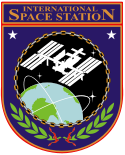Ekspedycja 20
| ||
 | ||
| Dane misji | ||
| Oznaczenie kodowe | Ekspedycja 20 | |
| Pojazd | ||
| Pojazd dowożący | Sojuz TMA-15 | |
| Załoga | ||
 | ||
| Dowódca | Giennadij Padałka | |
| Start | ||
| Miejsce startu | Bajkonur | |
| Początek misji | 27 maja 2009 10:34 UTC | |
| Misja ISS | ||
| Międzynarodowa Stacja Kosmiczna | ||
Ekspedycja 20 – dwudziesta ekspedycja na Międzynarodową Stację Kosmiczną (ISS), która rozpoczęła się w maju 2009 przybyciem trzech astronautów na pokładzie Sojuza TMA-15. Była to pierwsza ekspedycja, w której na pokładzie przebywało jednocześnie sześciu astronautów. Pierwszych trzech astronautów przeszło z Ekspedycji 19. Dwóch z nich przybyło na ISS na pokładzie Sojuza TMA-14, a trzeci (Kōichi Wakata) przeszedł z Ekspedycji 18. Przybył on promem Discovery STS-119. W trakcie ekspedycji były dwie zmiany jednego członka ekspedycji. Pierwszy raz w czerwcu 2009 przez prom Endeavour STS-127, a drugi raz w sierpniu 2009 przez prom Discovery STS-128.
Giennadij Padałka i Michael Barratt powrócili na Ziemię 11 października 2009 Sojuzem TMA-14. Pozostali na stacji astronauci oraz Maksim Surajew i Jeffrey Williams, którzy dotarli na ISS 2 października na pokładzie Sojuza TMA-16, weszli w skład Ekspedycji 21[1].
Załoga
Załoga pierwsza (od maja do czerwca 2009)
 Giennadij Padałka (3), dowódca - Roskosmos/Rosja
Giennadij Padałka (3), dowódca - Roskosmos/Rosja Michael R. Barratt (1), inżynier pokładowy 1 - NASA/USA
Michael R. Barratt (1), inżynier pokładowy 1 - NASA/USA Kōichi Wakata (3), inżynier pokładowy 2 - JAXA/Japonia
Kōichi Wakata (3), inżynier pokładowy 2 - JAXA/Japonia Frank De Winne (2), inżynier pokładowy 3 - ESA/Belgia
Frank De Winne (2), inżynier pokładowy 3 - ESA/Belgia Roman J. Romanienko (1), inżynier pokładowy 4 - Roskosmos/Rosja
Roman J. Romanienko (1), inżynier pokładowy 4 - Roskosmos/Rosja Robert Thirsk (2), inżynier pokładowy 5 - CSA/Kanada
Robert Thirsk (2), inżynier pokładowy 5 - CSA/Kanada
Załoga druga (od czerwca do sierpnia 2009)
 Giennadij Padałka (3), dowódca - Roskosmos/Rosja
Giennadij Padałka (3), dowódca - Roskosmos/Rosja Michael R. Barratt (1), inżynier pokładowy 1 - NASA/USA
Michael R. Barratt (1), inżynier pokładowy 1 - NASA/USA Timothy Kopra (1), inżynier pokładowy 2 - NASA/USA
Timothy Kopra (1), inżynier pokładowy 2 - NASA/USA Frank De Winne (2), inżynier pokładowy 3 - ESA/Belgia
Frank De Winne (2), inżynier pokładowy 3 - ESA/Belgia Roman J. Romanienko (1), inżynier pokładowy 4 - Roskosmos/Rosja
Roman J. Romanienko (1), inżynier pokładowy 4 - Roskosmos/Rosja Robert Thirsk (2), inżynier pokładowy 5 - CSA/Kanada
Robert Thirsk (2), inżynier pokładowy 5 - CSA/Kanada
Załoga trzecia (od sierpnia do października 2009)
 Giennadij Padałka (3), dowódca - Roskosmos/Rosja
Giennadij Padałka (3), dowódca - Roskosmos/Rosja Michael R. Barratt (1), inżynier pokładowy 1 - NASA/USA
Michael R. Barratt (1), inżynier pokładowy 1 - NASA/USA Nicole P. Stott (1), inżynier pokładowy 2 - NASA/USA
Nicole P. Stott (1), inżynier pokładowy 2 - NASA/USA Frank De Winne (2), inżynier pokładowy 3 - ESA/Belgia
Frank De Winne (2), inżynier pokładowy 3 - ESA/Belgia Roman J. Romanienko (1), inżynier pokładowy 4 - Roskosmos/Rosja
Roman J. Romanienko (1), inżynier pokładowy 4 - Roskosmos/Rosja Robert Thirsk (2), inżynier pokładowy 5 - CSA/Kanada
Robert Thirsk (2), inżynier pokładowy 5 - CSA/Kanada
(liczba w nawiasie oznacza liczbę lotów odbytych przez każdego z astronautów, łącznie z Ekspedycją 20)
Przypisy
- ↑ Soyuz TMA-16 (ang.). Space Facts, 2011-01-27. [dostęp 2014-07-05].
Linki zewnętrzne
- Ekspedycja 20 na stronie NASA (ang.)
- ISS: Expedition 20 (ang.). Space Facts, 2014-07-05. [dostęp 2014-07-05].
Media użyte na tej stronie
The flag of Navassa Island is simply the United States flag. It does not have a "local" flag or "unofficial" flag; it is an uninhabited island. The version with a profile view was based on Flags of the World and as a fictional design has no status warranting a place on any Wiki. It was made up by a random person with no connection to the island, it has never flown on the island, and it has never received any sort of recognition or validation by any authority. The person quoted on that page has no authority to bestow a flag, "unofficial" or otherwise, on the island.
Expedition 20 crewmembers take a break from training at NASA's Johnson Space Center to pose for a crew portrait. From the left (front row) are European Space Agency astronaut Frank De Winne, Expedition 20 flight engineer and Expedition 21 commander; cosmonaut Gennady Padalka, Expedition 19/20 commander; and cosmonaut Roman Romanenko, Expedition 20/21 flight engineer. From the left (back row) are Canadian Space Agency astronaut Robert Thirsk, Expedition 20/21 flight engineer; NASA astronauts Michael Barratt, Expedition 19/20 flight engineer; Nicole Stott, Expedition 20/21 flight engineer; Tim Kopra, Expedition 20 flight engineer; and Japan Aerospace Exploration Agency (JAXA) astronaut Koichi Wakata, 18/19/20 flight engineer.
The Expedition 20 patch symbolizes a new era in space exploration with the first six-person crew living and working onboard ISS and represents the significance of the ISS to the exploration goals of NASA and its international partners. The six gold stars signify the men and women of the crew. The astronaut symbol extends from the base of the patch to the star at the top to represent the international team, both on the ground and on orbit, that are working together to further our knowledge of living and working in space. The space station in the foreground represents where we are now and the important role it is playing towards meeting our exploration goals. The knowledge and expertise developed from these advancements will enable us to once again leave low earth orbit for the new challenges of establishing a permanent presence on the moon and then on to Mars. The blue, gray and red arcs represent our exploration goals as symbols of Earth, the moon and Mars.








